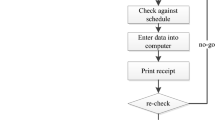Abstract
Backlogged empty containers have gradually turned into a serious burden to shipping networks. Empty container allocation has become an urgent settlement issue for the container shipping industry on a global scale. Therefore, this paper proposes an improved immune algorithm based recursive model for optimizing static empty container allocation which integrates with the global maritime container shipping network. This model minimizes the operating and capital costs during container shipping considering 0–1 mixed-integer programming. So an immune algorithm procedure based on a special twodimensional chromosome encoding is proposed. Finally, computational experiments are performed to optimize a 10-port static empty container shipping system. The results indicate that the proposed recursive model for static empty container allocation is effective in making an optimal strategy for empty container allocation.
Similar content being viewed by others
References
Shen W S, Khoong C M A. DSS for empty container distribution planning. Decision Support Systems, 1995, 15(1): 75–82
Choong S T, Cole M H, Kutanoglu E. Empty container management for intermodal transportation networks. Transportation Research Part E, Logistics and Transportation Review, 2002, 38(6): 423–438
Li J A, Leung S C H, Wu Y, Liu K. Allocation of empty containers between multi-port. European Journal of Operational Research, 2007, 182(1): 400–412
Crainic T G, Gendreau M, Dejax P. Dynamic and stochasticmodels for the allocation of empty containers. Operations Research, 1993, 41(1): 102–126
Cheung R K, Chen C Y. A two-stage stochastic network model and solution methods for the dynamic empty container allocation problem. Transportation Science, 1998, 32(2): 142–162
Jula H, Chassiakos A, Ioannou P. Port dynamic empty container reuse. Transportation Research Part E, Logistics and Transportation Review, 2006, 42(1): 43–60
Lam S W, Lee L H, Tang L C. An approximate dynamic programming approach for the empty container allocation problem. Transportation Research Part C, Emerging Technologies, 2007, 15 (4): 265–277
Shintani K, Imai A, Nishimura E, Papadimitriou S. The container shipping network design problem with empty container repositioning. Transportation Research Part E, Logistics and Transportation Review, 2007, 43(1): 39–59
Cullinane K, Khanna M. Economies of scale in large containerships: optimal size and geographical implications. Journal of Transport Geography, 2000, 8(3): 181–195
Farmer J D, Packard N H, Perelson A S. The immune system, adaptation, and machine learning. Physica D: Nonlinear Phenomena, 1986, 2(1–3): 187–204
Yang J G, Luo Z H. Coalition formation mechanism in multi-agent systems based on genetic algorithms. Applied Soft Computing, 2007, 7(2): 561–568
Author information
Authors and Affiliations
Corresponding author
Additional information
Zijian Guo received his PhD from Nihon University, Japan, in 1995. From 1999 to 2001, he was a Post-Doctoral Fellow of the Department of Civil Engineering, University of Tokyo, Japan. In 2002, he worked as a Post-Doctoral Fellow in the UPS Center for Worldwide Supply Chain Management, University of Louisville, USA. Currently, he is a Professor and doctoral advisor in the Faculty of Infrastructure Engineering, Dalian University of Technology, China. His research interests cover optimization of integrated transport systems, and port system and logistics. He is also editor-in-chief of Port Planning and Layout (third edition).
Wenyuan Wang obtained her bachelor degree in port, waterway, and coastal engineering in 2006, and her master degree in harbor, coastal and offshore engineering in 2009, both from Dalian University of Technology. Currently, she is a PhD student in the Faculty of Infrastructure Engineering in the same university. She maintains active research interests in the optimization of container transportation networks, simulation and optimization of port system.
Guolei Tang received his PhD from Dalian University of Technology in 2009. From 2009 till now, he has worked as a Postdoctoral Fellow and then a lecturer in Faculty of Infrastructure Engineering, Dalian University of Technology. He has completed series of academic research and consultancy projects in the areas of simulation and optimization of port systems, port logistics, and network optimization.
Jun Huang received his bachelor degree in Port, Waterway, and Coastal Engineering from Dalian University of Technology in 2005, and master degree in Harbor, Coastal and Offshore Engineering in 2008 both from Dalian University of Technology. Now, he is an engineer in transport planning and research institute ministry of communications. His research interest is port Planning.
Rights and permissions
About this article
Cite this article
Guo, Z., Wang, W., Tang, G. et al. A recursive model for static empty container allocation. Front. Comput. Sci. China 5, 486–495 (2011). https://doi.org/10.1007/s11704-011-1013-y
Received:
Accepted:
Published:
Issue Date:
DOI: https://doi.org/10.1007/s11704-011-1013-y




